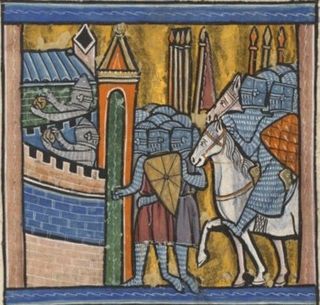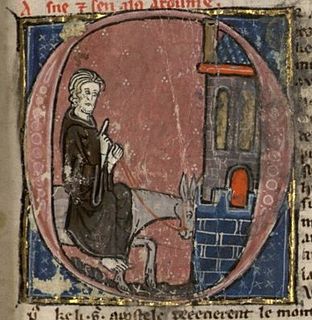Baldwin Chauderon (died 1097) was a knight from Berry who was killed during the siege of Nicaea. [1] [2] It is unclear whether or not he belonged to any of the major armies of the First Crusade.

Berry is a region located in the center of France. It was a province of France until départements replaced the provinces on 4 March 1790, when Berry became divided between the départements of Cher and Indre.

The Siege of Nicaea took place from May 14 to June 19, 1097, during the First Crusade. The city belonged to the Seljuk Turks and opted to surrender to the Byzantines in fear of the crusaders breaking into the city. The siege was followed by the Battle of Dorylaeum, and the siege of Antioch, all of which are in modern Turkey.

The First Crusade (1095–1099) was the first of a number of crusades that attempted to recapture the Holy Land, called for by Pope Urban II at the Council of Clermont in 1095. Urban called for a military expedition to aid the Byzantine Empire, which had recently lost most of Anatolia to the Seljuq Turks. The resulting military expedition of primarily Frankish nobles, known as the Princes' Crusade, not only re-captured much of Anatolia but went on to conquer the Holy Land, which had fallen to Islamic expansion as early as the 7th century, and culminated in July 1099 in the re-conquest of Jerusalem and the establishment of the Kingdom of Jerusalem.
Baldwin was described by William of Tyre as “a rich man and a good knight” [3] and is associated in William's work with Baldwin de Ghent [4] (presumably Baldwin II, Lord of Aalst, [5] part of the army of Robert II of Flanders), and Guy de Possesse [6] of Champagne. All three died on the same day, with the two Baldwins dying of an unknown illness and Guy dying from a stone that the Turks had catapulted onto his head. (Note that other sources say Baldwin de Ghent died when shot by an arrow.)

William of Tyre was a medieval prelate and chronicler. As archbishop of Tyre, he is sometimes known as William II to distinguish him from his predecessor, William I, the Englishman and former Prior of the Church of the Holy Sepulchre, who was Archbishop of Tyre from 1127 to 1135. He grew up in Jerusalem at the height of the Kingdom of Jerusalem, which had been established in 1099 after the First Crusade, and he spent twenty years studying the liberal arts and canon law in the universities of Europe.
The Army of Robert the Crusader was led by Robert II, Count of Flanders, and followed the retinue of his kinsman Godfrey of Bouillon. His wife Clementia of Burgundy was regent of Flanders in his absence. The known members of the army, mostly Flemish, included the ones listed below, as reported in histories of the First Crusade. Unless otherwise noted, references are to the on-line database of Riley-Smith, et al., and the hyperlinks therein provide details including original sources. The names below are also referenced in the Riley-Smith tome, Appendix I: Preliminary List of Crusaders. Those references are not shown unless they appear elsewhere in the text of the book. Articles that are hyperlinked to a more detailed article in this encyclopædia rely on the latter for references.
Their bodies were carried to a church dedicated to St. Simeon by men from Flanders and Burgundy who held a vigil, lighting 30 candles until the sermon the next day. They were buried in a nearby churchyard. The three knights were immortalized in the poem La Chanson d’Antioche .

Nicaea or Nicea was an ancient Greek city in northwestern Anatolia, and is primarily known as the site of the First and Second Councils of Nicaea, the Nicene Creed, and as the capital city of the Empire of Nicaea following the Fourth Crusade in 1204, until the recapture of Constantinople by the Byzantines in 1261.

The Chanson d'Antioche is a chanson de geste in 9000 lines of alexandrines in stanzas called laisses, now known in a version composed about 1180 for a courtly French audience and embedded in a quasi-historical cycle of epic poems inspired by the events of 1097–99, the climax of the First Crusade: the conquest of Antioch and of Jerusalem and the origins of the Crusader states. The Chanson was later reworked and incorporated in an extended Crusade cycle, of the 14th century, which was far more fabulous and embroidered, more distinctly romance than epic.


